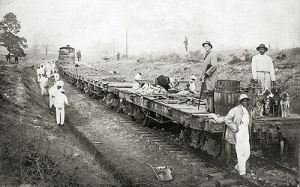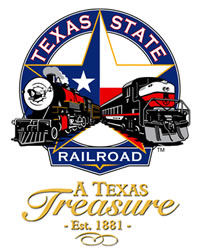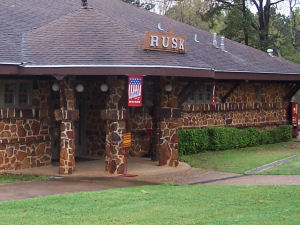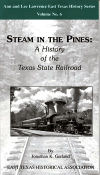
HOME
INTRO
SYMBOLS
ALMANAC
ECONOMY
GEOGRAPHY
STATE MAPS
PEOPLE
FORUM
NEWS
COOL SCHOOLS
STATE QUIZ
STATE LINKS
BOOK STORE
MARKETPLACE
NETSTATE.STORE
NETSTATE.MALL
GUESTBOOK
CONTACT US


Dbl click any word in
document for definition.
Texas State Railroad

Texas State Railroad: Texas State Railroad
A seasonal convict work gang clears ditches along the tracks
of the Texas State Railroad between Rusk and Palestine
in about 1913.. N.d. Photograph. The History Center,
Dibol, Texas. Web. 14 Mar 2012.
Over a period of six years, between 1877 and 1883, the State of Texas built a new penitentiary near Rusk, in East Texas. The purpose was to alleviate over-crowding at the penitentiary in Huntsville and to bring in convicts to exploit the iron-ore resources in East Texas.
The beginnings of the Texas State Railroad can be traced back to 1896 when five miles of track had been completed to serve the iron foundry operated by the Texas state penitentiary. The penitentiary foundry produced pig iron, blocks of crude iron, and implements for commercial sale.
From North Rusk to the smelter (blast furnace) known as "Old Alcalde" the railroad carried wood and iron ore; wood to fuel the furnace and iron ore from which to extract iron.
Eventually Old Alcalde was replaced by a larger furnace which expanded the output of the foundry.
By 1904 another five miles of track had been laid, extending the railroad to Maydelle.
Rusk native, lawyer, and former manager of the International-Great Northern Railroad, Thomas Campbell served as Governor of the State of Texas from 1907 to 1911. During his first term he came up with the idea creating some additional revenues for the state by turning the penitentiary railroad from an industrial railroad, serving the penitentiary into a "common carrier" to transport passengers and regular freight.
The Texas Legislature approved his request to operate the railroad as a common carrier. The tracks were extended another 22 1/2 miles, from Maydelle to Palestine. Depots were maintained in Rusk, Maydelle, and Palestine. Regular (common carrier) service began on the "Texas State Railroad, in June, 1907.
In 2003, spurred on by the Friends of the Texas State Railroad, House Concurrent Resolution No. 34 was introduced in the Texas State House of Representatives. State Representative Chuck Hopson lead the way.
H.C.R. No. 34
HOUSE CONCURRENT RESOLUTION
WHEREAS, The State of Texas has customarily recognized a variety of official state symbols as tangible representations of the state's historical and cultural heritage; and
WHEREAS, The Texas State Railroad, an East Texas fixture for more than a century, had its origins in the iron industry boom that East Texas experienced in the 1870s and 1880s; in 1875 the state legislature authorized construction of a new penitentiary near Rusk in order to develop the iron ore resources of the area, as well as to relieve overcrowding at the penitentiary in Huntsville; the ensuing iron works at the East Texas Penitentiary provided material for the present State Capitol, including the iron that was used in the building's columns and dome; and
WHEREAS, To facilitate the transport of iron ore for the smelter and foundries, as well as timber for the prison's sawmill, construction was begun in 1881 on a line known officially as the Texas State Railroad, and by 1909 the road had been extended to Palestine in adjacent Anderson County; and
WHEREAS, In addition to hauling raw materials to the penitentiary, the railroad offered regular passenger and freight service from 1907 to 1921; prison inmates, who had constructed the entire line, made up the train crew, except for the engineer, during much of this period; and
WHEREAS, The iron works at the prison closed in 1913, and eight years later the state began leasing the track of the Texas State Railroad to private companies; over the next half century the line served in particular to move lumber and timber products; and
WHEREAS, In 1972, after most of the road had remained unused for several years, the Texas Legislature conveyed the line to the Parks and Wildlife Department; at the urging of rail enthusiasts, and after studying the feasibility of such a project, it was decided to restore the line as part of a state historical park and to dedicate the complex to the preservation and interpretation of the country's railroad heritage; and
WHEREAS, On July 4, 1976, as part of the nation's Bicentennial celebration, the Texas State Railroad State Historical Park opened to the delight of countless citizens across the state; in 2002, more than 130,000 people visited the park, including 83,000 from outside the area; of those visitors, 41,110 took a ride on one of the trains that makes the run through the piney woods and rolling hardwood creek bottoms between Palestine and Rusk; and
WHEREAS, A fully self contained system, the Texas State Railroad operates four steam engines and four antique diesel locomotives; in addition, it maintains a complete steam engine restoration shop, 29 miles of track, and 24 bridges, including one over the Neches River; and
WHEREAS, Included in the railroad's stock are Steam Engine No. 201, donated by the City of Abilene and once used by the Texas & Pacific Railroad; Steam Engine No. 300, donated by Temple Industries in Pineland; Steam Engine No. 400, purchased from the Magma Copper Mine in Magma, Arizona, and once used by the Tremont & Gulf Railway in Central Louisiana; Steam Engine No. 500, owned at one time by the City of San Angelo; and Steam Engine No. 610, operated by the Texas & Pacific between Shreveport and El Paso until 1950 and displayed in Fort Worth for a number of years; in the 1970s the publisher and philanthropist Amon G. Carter, Jr., financed the restoration of No. 610, and the engine became one of two that pulled the Freedom Train through Texas during the Bicentennial; and
WHEREAS, Over the years, the railroad has received significant attention in many quarters and has been featured in television series, documentaries, commercials, music videos, and full length films; and
WHEREAS, The Texas State Railroad and its historical park have contributed greatly to the prosperity of the surrounding area; in 2002 they injected nearly $1.5 million into the local economy, generated more than $4.6 million in sales, and produced a more than $1.8 million impact on the income of local residents; and
WHEREAS, Deeply rooted in the life and industry of East Texas, the Texas State Railroad is today one of the largest steam train operations in the country; through its preservation program, its excursion tours, and a wide variety of educational efforts, the railroad constitutes an outstanding asset to the Lone Star State; now, therefore, be it
RESOLVED, That the 78th Legislature of the State of Texas hereby designate the Texas State Railroad as the official Railroad of Texas.
The Texas State Railroad became the official railroad of Texas when Governor Rick Perry Signed House Concurrent Resolution No. 34 on June 22, 2003.
Managed by the Texas State Parks and Wildlife Department from 1976, the Texas State Railroad was privatized with a contract with American Heritage Railways in September of 2007.
American Heritage Railways refers to itself as "the country's premier tourist rail operator and the industry expert in rail-related special event management."
In addition to the Texas State Railroad, the organization also manages the Durango & Silverton Narrow Gauge Railroad, in Colorado, the Great Smokey Mountains Railroad, in North Carolina, the touring Polar Express Ride, and the Little Engine That Could Tour.
Texas Law

Texas State Railroad: Texas State Railroad
Logo: Texas State Raiload
The Texas State Railroad was named the official railroad of Texas by House Concurrent Resolution and is not, therefore, listed in the Texas Statutes.
Only a few of Texas' myriad symbols were actually adopted by an act of the legislature and written into the Texas Statutes.
Sources...
The State of Texas. Texas Legislature Online. House Concurrent Resolution No. 34. Austin: The State of Texas, 2003. Web.
Lucko, Paul M.. "RUSK PENITENTIARY." The Handbook of Texas Online. Texas State Historical Association., n.d. Web. 14 Mar 2012.
Richards, Amy. "TEXAS STATE RAILROAD." The Handbook of Texas Online. Texas State Historical Association., n.d. Web. 14 Mar 2012.
Richards, Amy. "TEXAS STATE RAILROAD STATE HISTORICAL PARK." The Handbook of Texas Online. Texas State Historical Association., n.d. Web. 14 Mar 2012.
"About." Texas State Railroad. American Heritage Railways, n.d. Web. 14 Mar 2012.
The State of Texas. Texas Legislature Online. Texas Statutes. Austin: The State of Texas, 2012. Web.
Additional Information

Texas State Railroad: Texas State Railroad
Rusk Depot
TEXAS STATE RAILROAD: Texas State Historical Association: The Handbook of Texas Online.
TEXAS STATE RAILROAD STATE HISTORICAL PARK: Texas State Historical Association: The Handbook of Texas Online.
RUSK PENITENTIARY: Texas State Historical Association: The Handbook of Texas Online.
IRON AND STEEL INDUSTRY: Texas State Historical Association: The Handbook of Texas Online.
Texas State Railroad: Official website.
More symbols & emblems: Complete list of official Texas state symbols from NETSTATE.COM.

Steam in the Pines
Jonathan K. Gerland
Steam in the Pines: A History of the Texas State Railroad, by Jonathan K. Gerland. 99 pages. Publisher: East Texas Historical Association (2004) Drawn mostly from primary sources, this book tells the exciting, and amazing, story of how the Texas State Railroad Railroad with humble beginnings as an industrial spur built and operated by the Texas prison system more than 120 years ago, developed into one of the most popular and unique tourist train operations in the country today.

